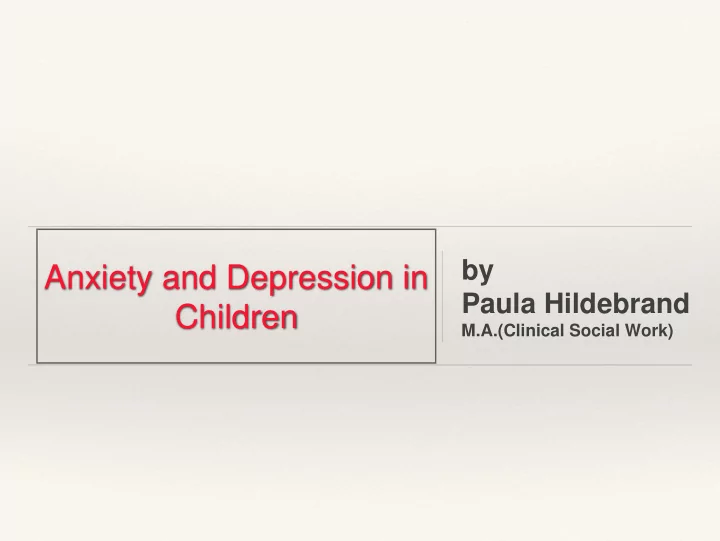

by Anxiety and Depression in Paula Hildebrand Children M.A.(Clinical Social Work)
The ‘unhappy’ child ❖ What is depression from a child’s perspective? ❖ What is anxiety from a child’s perspective? ❖ What makes a child’s world work? ❖ What matters to a child?
What is ‘wrong’? ❖ Anomie ❖ Socialisation ❖ Self ❖ Fear ❖ Lack of belief ❖ Digital era ❖ The relationship between anxiety and depression in children
Psychosocial causes ❖ Social exclusion ❖ Parental separation and divorce ❖ Rise in lone parent households ❖ Less extended family support ❖ Racial discrimination ❖ Child abuse
❖ Increase in alcohol and substance abuse ❖ Widening of the gap between the rich and the poor ❖ Genetic predisposition ❖ Parental mental illness ❖ Domestic violence ❖ Crime
What is ‘right’ and ‘healthy’? ❖ WHO describes health as a state of complete physical, mental and social well-being and not merely the absence of disease or infirmity. ❖ It is the extent to which an individual or group is able to realise aspirations, meet needs, and to change or cope with their environment.
A healthy child needs… ❖ Physical needs to be met ❖ Secure relational attachments ❖ Freedom to play outside ❖ Community ❖ Good feel-goods ❖ Stimulated learning ❖ To be loved
“Psychological well -being is as important for childhood - John Bowlby development as physical nourishment”
Attachment ❖ Security of Attachment ❖ Trust ❖ Belonging and Acceptance ❖ Availability of responsive and sensitive carers ❖ Opportunities and freedom for expression through play, learning and relationships ❖ Social bonding
Resilience ❖ Why some children aren’t depressed? ❖ Understanding pain and discomfort ❖ Life management skills ❖ Problem solving skills ❖ Socialisation ❖ I am, I can, and I have
Treatment ❖ To medicate or not to medicate ❖ What do we treat first, anxiety or depression? ❖ Hopeless, Helpless and Hiding ❖ Client centred ❖ Work as a team around the child - village
Approaches ❖ Cognitive Behavioural Therapy ❖ Small children ❖ Play Therapy: Gestalt; Non-direct and Direct ❖ Adolescents: ❖ Dialectical Behavioural Therapy; Inter- relational Therapy ; Talk; Narrative Therapy
My approach… I’ve self esteem I’m resilient I belong I trust
Therapy with the child ❖ Create a ‘safe place’ ❖ Build trust and acceptance ❖ Validation of emotions ❖ Teach social skills ❖ Encourage containment ❖ Develop self identity and worth
Therapy with the family ❖ Emotionally support ❖ Empower with knowledge ❖ Normalising ❖ Boundaries ❖ Parenting skills ❖ Siblings
Others, e.g. teacher.. ❖ Confidentiality ❖ Share to empower and manage ❖ Share to gain insight ❖ Collective observations ❖ Shared responsibility
Some areas of growth ❖ Learn to manage fears not eliminate them ❖ To develop tolerance for fear/pain /discomfort ❖ Not to avoid stressors ❖ To value emotions ❖ To grow as a social being ❖ To learn how to have fun ❖ “I am strong”
Tools ❖ ‘ Brave’ and ‘Scared’ ❖ The big door ❖ Mountain climber ❖ Statues ❖ Balloon of fear ❖ Ronnie ❖ Lego blocks - break it ❖ Use of animals up ❖ Worry web ❖ Fuzzy in the cupboard ❖ Dart board of ❖ Heart with many friendship colours
Hold. Hope. Help
Recommend
More recommend